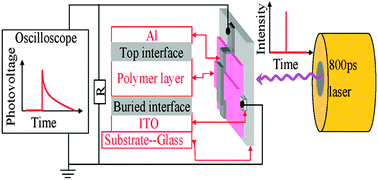Charge dynamics in solar cells with a blend of π-conjugated polymer-fullerene studied by transient photo-generated voltage†
Abstract
The biphasic feature of transient photo-generated voltage (TPV) is investigated in organic solar cells (OSCs) with a blend active layer of poly(3-hexylthiophene) (P3HT) and phenyl C61 butyric acid methyl ester (PCBM). The positive and negative components in biphasic TPV are explained through PCBM only and P3HT only devices. The negative and positive components are ascribed to the dipole formation at the buried interface of P3HT/indium tin oxide (ITO) and PCBM/ITO respectively. Based on these findings, two fundamental phenomena are revealed as follows: (1) interfacial modification on the buried interface inverts the negative component in biphasic TPV to a positive component, which prevents the leakage current channel in the conventional OSC structure; and (2) the


 Please wait while we load your content...
Please wait while we load your content...